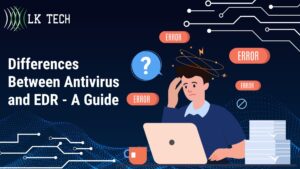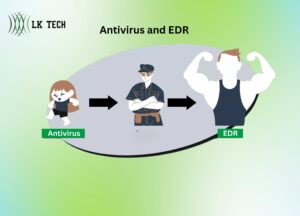The Key Differences Between Antivirus and EDR Solutions
With cyber threats continually evolving, businesses must understand the limitations of traditional antivirus software and why more advanced protections like endpoint detection and response (EDR) are now essential. This article will clarify the key differences between antivirus and EDR to help you make informed decisions when securing your organization against modern cyber threats.

- Differences Between Antivirus and EDR - A Guide
How Antivirus Protection Works
Antivirus software has been around for decades, relying on signature-based detection to identify known malicious files. When a file attempts to execute on an endpoint, the antivirus scanner checks it against a database of file signatures. If a match occurs, indicating the file is malware, the antivirus blocks it from running and quarantines or deletes it to contain the threat.
Antivirus software typically includes real-time scanning, manual scanning, and scheduled scanning options. Real-time scanning checks files as they are opened, downloaded, or executed, providing protection in the moment. Manual scanning allows users to perform on-demand scans of specific files or directories. Scheduled scanning runs automatically at set times to catch any dormant malware. All these scanning options rely on comparing files against "definitions" in the antivirus signature database.
While antivirus still offers a baseline of protection against common malware and viruses, it has significant blindspots:
- Signature-based detection fails against new, unknown threats that aren't yet in the antivirus signature database. Sophisticated attackers frequently modify malware to evade detection.
- Many modern attacks use fileless techniques that don't rely on malware files at all, completely evading antivirus. Fileless attacks leverage legitimate operating system tools, applications, and processes to carry out malicious actions.
- Antivirus lacks context beyond individual endpoints, missing signs of wider malicious activity across networks, users, or systems that could indicate an active larger intrusion.
In summary, antivirus can only detect what it already knows based on pre-identified signatures. It cannot see novel threats until researchers analyze them, extract signatures, and push updates to antivirus software. This reactive model is no longer adequate in today's rapidly evolving threat landscape.
The Limitations of Antivirus in Today's Threat Landscape
Cybercriminals now utilize sophisticated techniques like living off the land attacks to remain undetected by traditional antivirus. These tactics leverage built-in, legitimate operating system tools or hijack trusted software through vulnerabilities to evade detection. For example, the attacker may abuse PowerShell, use malicious scripts, or inject code into vulnerable processes to execute malicious actions discreetly, avoiding antivirus scrutiny.
Antivirus also takes an inherently reactive approach, unable to respond in real-time until signatures are updated after an attack is discovered and analyzed. This leaves a massive window of exposure that attackers are all too eager to exploit. In many cases, by the time antivirus vendors can study new threats and deploy signature updates, the damage is already done.
Modern attacks like advanced persistent threats (APTs) are specifically designed to infiltrate systems undetected over prolonged periods by living off the land and avoiding malware. Antivirus would have no means of seeing this activity as it occurs.
How Endpoint Detection & Response Closes the Gaps
Endpoint detection and response (EDR) solutions deliver a much more proactive form of protection by continuously monitoring endpoint activity and events using behavioral analysis techniques. This allows EDR to detect and respond to never-before-seen threats that don't have malware signatures.
EDR relies on sensors installed on endpoints across the environment. These sensors collect extensive data on system events like process execution, file changes, registry modifications, network connections, and user activity. EDR aggregates this data across all endpoints to gain full visibility into what is occurring.
Machine learning and behavioral analytics are applied to baseline normal activity and identify anomalous events that could signal malicious activity. For example, EDR can detect abnormal processes interacting with system areas like the kernel, suspicious registry modifications, connections to risky IP addresses, and other indicators of compromise.
Key capabilities of EDR include:
- Real-time monitoring of endpoint processes, network connections, registry changes, etc. for signs of compromise
- Behavioral analysis leveraging machine learning to baseline normal activity and identify anomalous behavior that could signal an attack
- Rapid response options like isolating infected endpoints before damage spreads
- Retrospective security analytics to reconstruct the full scope of a breach after the fact
- Threat hunting to proactively seek out dormant or hidden threats
Additionally, leading EDR solutions like Sophos Intercept X integrate with antivirus to offer multilayered defenses. The antivirus provides signature-based blocking of known malware, while the EDR monitors for zero-day and advanced attacks using behavioral analytics. Some EDR solutions can even roll back changes made by ransomware.
This powerful combination of real-time monitoring, advanced analytics, and post-attack investigations enables EDR to fill critical security gaps left by traditional antivirus alone.
Some key differences between antivirus and EDR solutions:
Antivirus
- Signature-based detection
- Reactive protection after updates
- Isolated visibility per endpoint
- Blocks known malware only
EDR
- Behavior-based monitoring
- Real-time prevention and detection
- Holistic visibility across endpoints
- Machine learning finds novel threats
- Retrospective analysis
Why Antivirus Alone Is No Longer Sufficient
While antivirus still has a place in today's security stack as a foundational defense against widespread commodity threats, it's no longer sufficient as a standalone solution. Antivirus leaves organizations dangerously exposed to modern threat tactics including:
- Fileless attacks - Living off the land attacks and other fileless techniques allow adversaries to cause damage without any malware files for antivirus to detect.
- Zero-day exploits - Antivirus can't block what it doesn't recognize. Unknown zero-days bypass traditional signature-based defenses.
- Advanced persistent threats - Slow-moving, stealthy attacks are invisible to antivirus as they infiltrate networks and quietly move laterally.
- Ransomware - Signature updates may come too late once ransomware has already encrypted files.
These advanced threats are specifically designed to evade traditional security tools. According to SophosLabs, the vast majority of today's attacks now leverage fileless techniques to avoid antivirus detection.

- Differences Between Antivirus and EDR - A Guide
Strengthen Your Defenses with Next-Gen Endpoint Protection
While antivirus still has a place in today's security stack, it's no longer sufficient as a standalone solution. EDR capabilities are now essential to detect and neutralize the advanced threats that routinely bypass antivirus.
To effectively secure your business, a platform like Sophos Central combines EDR, next-gen antivirus, firewall, web/application security, cloud workload protection, encryption, and more - all managed from a unified cloud console.
Some key features include:
- EDR - Continuous monitoring, advanced analytics, and threat hunting to detect stealthy attacks
- Next-gen antivirus - Malware prevention using both signature-less and signature-based techniques
- Firewall - Network-level controls and visibility into lateral movement
- Web security - Filters malicious websites and downloads at the gateway
- Cloud workload protection - Secures cloud environments against misconfigurations and threats
- Encryption - Protects sensitive data from unauthorized access
- Cloud management - Unified visibility and control across all defenses
Sophos EDR goes far beyond antivirus, correlating billions of data points across your environment to find the subtle indicators of attack that get missed by traditional defenses. Paired with real-time threat intelligence from SophosLabs, businesses get an early warning system for active threats along with the ability to investigate, contain, and neutralize advanced attacks.
Sophos EDR also integrates seamlessly with Sophos' synchronized security platform to share real-time threat intelligence across defenses like next-gen firewalls and secure email gateways. This further strengthens protection and enables coordinated responses to attacks.
With attackers constantly evolving innovative tools and techniques to evade traditional security measures, proactive threat detection and response is a must. Don't leave gaps in your defenses - reach out to learn how we can help strengthen your endpoint security posture.
In LK Tech, an IT services company based in Cincinnati, Ohio, we provide innovative solutions tailored to your unique logistics needs. Our team delivers top-notch service and expertise to help you stay ahead in the industry. Contact us today to find out how.


